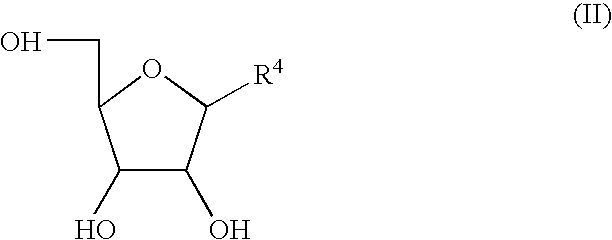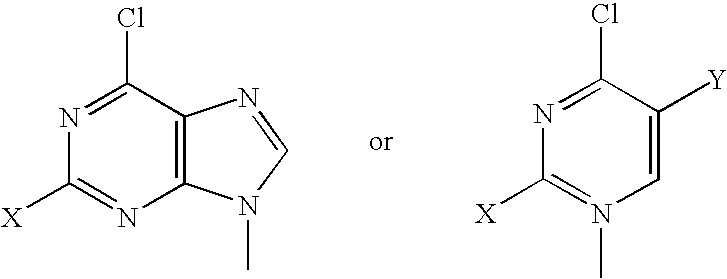Processes for production of nucleosides
a technology of nucleosides and processes, applied in the field of nucleoside compounds, can solve the problems of high reactivity of reagents, serious quality problems, and inability to use them on an industrial scale, and achieve the effects of facilitating easy control of reaction, and reducing the risk of contamination
- Summary
- Abstract
- Description
- Claims
- Application Information
AI Technical Summary
Benefits of technology
Problems solved by technology
Method used
Image
Examples
preparation example 1
2′,3′,5′-Triacetyl-6-chloropurineriboside
[0114] 2′,3′,5′-Triacetylinosine (20 g) was added to chloroform (160 ml) and N,N-dimethylformamide (2.7 g), thionyl chloride (19.9 g) was added dropwise thereto, and the mixture was stirred under reflux for 3 hours. Water (200 ml) was added under cooling in an ice bath. The mixture was stirred for 1 hour and partitioned. The organic layer was washed with 5% aqueous sodium hydrogen carbonate solution and saturated brine, dried over sodium sulfate, and concentrated to dryness to give 2′,3′,5′-triacetyl-6-chloropurineriboside (24.4 g) as an oil.
[0115]1H-NMR(CDCl3, ppm) δ: 2.10 (3H, s), 2.12(3H, s), 2.17(3H, s), 4.37-4.51(3H, m), 5.64-5.67(1H, m), 5.94-5.97(1H, m), 6.24-6.25(1H, d, J=5.2 Hz), 8.30(1H, s), 8.79(1H, s).
example 1
6-Chloropurineriboside
[0116] 2′,3′,5′-Triacetyl-6-chloropurineriboside (oil, 6.0 g) was dissolved in methanol (30 ml). The mixture was cooled to 5° C., and 1N sodium hydroxide-methanol solution (0.6 ml) was added. The mixture was stirred for 5 hours. Acetic acid (0.04 ml) and ethyl acetate (30 ml) were added to the reaction mixture, and the mixture was stirred under ice-cooling for 1 hour. The precipitate was collected by filtration, washed with ethyl acetate, and vacuum dried at 40° C. to give the title compound (3.08 g).
[0117]1H-NMR(DMSO-d6, ppm) δ: 3.59-3.74 (2H, m), 4.00-4.01(1H, s), 4.19-4.21(1H, m), 4.59-4.62(1H, m), 5.10-5.12(1H, m), 5.27(1H, d, J=5.1 Hz), 5.59(1H, d, J=5.8 Hz), 6.06(1H, d, J=5.3 Hz), 8.83(1H, s), 9.06(1H, s).
example 2
2′,3′-Isopropylidene-6-chloropurineriboside
[0118] 6-Chloropurineriboside (10.0 g) was suspended in acetone (70 ml), 2,2-dimethoxypropane (7.3 g) and p-toluenesulfonic acid monohydrate (3.3 g) were added thereto, and the mixture was stirred at 10° C. for 3 hours. The reaction mixture was added to a solution of sodium hydrogen carbonate (1.8 g) and water (70 ml). The mixture was concentrated under reduced pressure and stirred at 20° C. for 3 hours. The precipitate was collected by filtration, washed with water, and dried overnight at 40° C. under reduced pressure to give 2′,3′-isopropylidene-6-chloropurineriboside (9.7 g).
[0119]1H-NMR(DMSO-d6, ppm) δ: 1.34 (3H, s), 1.55(3H, s), 3.50-3.58(2H, m), 4.30-4.32(1H, m), 4.97-4.99(1H, m), 5.09-5.11(1H, s), 5.41-5.43(1H, s), 6.28(1H, d, J=2.4 Hz), 8.82(1H, s), 8.87(1H, s).
PUM
 Login to View More
Login to View More Abstract
Description
Claims
Application Information
 Login to View More
Login to View More - R&D
- Intellectual Property
- Life Sciences
- Materials
- Tech Scout
- Unparalleled Data Quality
- Higher Quality Content
- 60% Fewer Hallucinations
Browse by: Latest US Patents, China's latest patents, Technical Efficacy Thesaurus, Application Domain, Technology Topic, Popular Technical Reports.
© 2025 PatSnap. All rights reserved.Legal|Privacy policy|Modern Slavery Act Transparency Statement|Sitemap|About US| Contact US: help@patsnap.com



